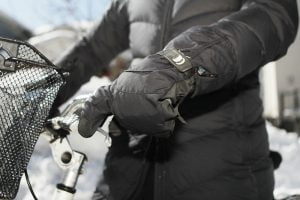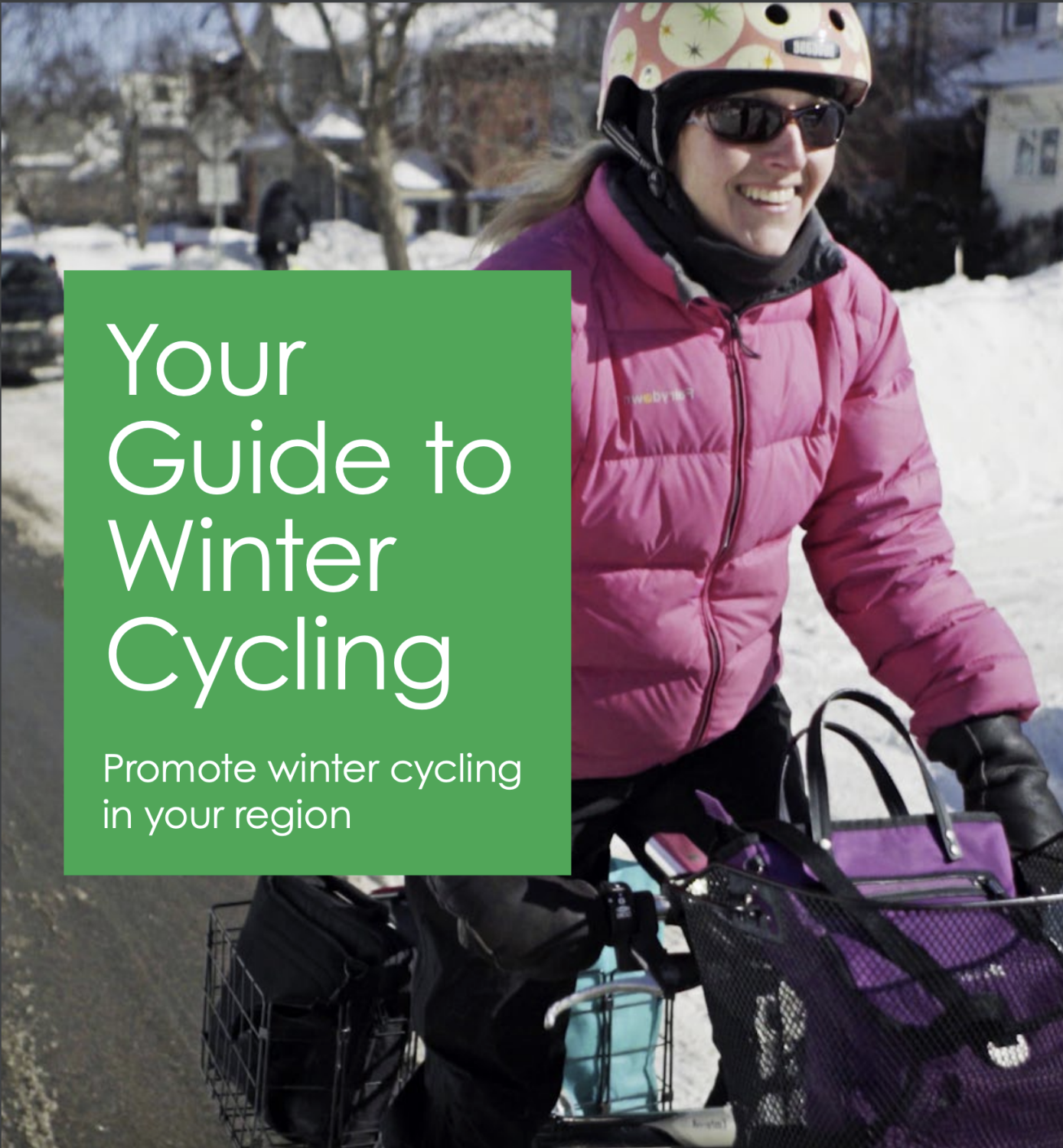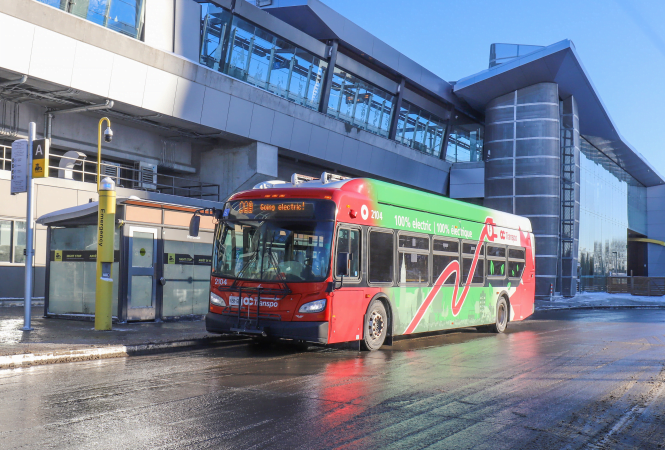Winter transportation
Your guide to winter cycling
Cycling is a rewarding activity and can be done year-round. If you are just beginning to cycle in the colder months, take the time to learn and build your confidence. With some bike preparation, a good route and the right clothes you can extend your cycling season.

Getting Started
Some tips for getting started:
Bike on the nice days
Don’t start out in a snowstorm! There are plenty of beautiful sunny days in the winter when the roads are clear.
Combination
Use public transportation and combine it with a bike ride. Many buses have bicycle racks on the front well into the winter season or year-round.
Leisure first
Try cycling in different conditions for leisure before you commit to a commute.
There are five main things to keep in mind when riding year-round.
These are fundamental regardless of where you live, although some become more important in colder, snowier climates.
Route Planning
Get to know which routes are regularly plowed, where the pinch points may be and alternatives to heavily travelled car routes.
Gear
Make sure you’re properly clothed for some of the extremes that winter can throw at you. This means dress for warmth, visibility and be prepared for changes in weather.
Visibility
With less light and fewer riders on the roads, it is essential to equip your bike with lights so that you can be seen by other road users.
Skills
Winter riding calls for a slightly different skillset than the warmer months. Become aware of the challenges and skills to overcome them.
Bike
Use a suitable bicycle that is properly outfitted and maintained.
Your bicycle
Your winter ride
Consider using an old bike (or buy a used bike) as a designated winter bike to protect your regular commuter bike from the elements. Salt, sand and grit wear down gear cogs, cause rust and get into suspension and braking systems.
A mountain, hybrid or commuter style bike will give you the most traction. A bike with aluminum rimmed wheels will last longer and provide much safer braking. If you ride frequently in the winter, you may need to replace your winter bike every few years.
Note: Fat bikes (or winter bikes) are fun but they are an expensive choice for a winter commuter bike and best used in clean snow conditions.


Bicycle Tires
Lower the air pressure in your tires, without going below the manufacturer’s recommended range to get a better grip on the road. The PSI range can be found written on the sidewall of most tires.
For traction in snow, thick-tread mountain bike tires are a good option. If you live in an area with a regular freeze/thaw cycle you may want to invest in studded tires. These tires have good traction and small metal protrusions that grip onto slippery patches such as ice. If you only have the budget for one, put it on the front. Your front tire guides your bike’s position. The weight of your body/panniers will help with traction in the rear. Depending on how much you ride, you may be able to use the same studded tire for several winter seasons.
For lightly packed snow or slush, thin tires can be very effective for cutting through the snow to reach the pavement.
Know the conditions that are most common in your area and choose your tires accordingly. Ask other winter cyclists in your area for their recommendations.
Brakes
Brakes can be affected by winter conditions. Cables rust and parts seize. Your brakes are important so be sure they are operational every time you head out.
Bags/Baskets/Panniers
There are many weather resistant options for carrying belongings on a bicycle.
Bags
Carrying a heavy bag on your back creates a higher centre of gravity. This can be challenging in winter because the shifting weight can cause instability in slippery conditions. Consider a well fitted backpack for lighter loads only.
Baskets
Baskets can be attached at the front or back and are very convenient any time of year. A well attached milk crate on a rear rack is a cost effective option.

Panniers
There are many types of weather proof panniers available. This is a great option for heavier loads. The lower centre of gravity can help with stability.
Tip: Panniers make your bike appear wider and create a larger visual footprint, therefore, motorists tend to give you more space when passing.
Fenders
In winter, full fenders are recommended. The fenders will protect you from splash ups and you will remain dryer, cleaner and warmer. Leave the maximum room between your tire and fender to allow for packed snow build up.
When riding, leave a little space behind other cyclists to keep clear of the debris they may kick up.
Consider adding a frame fender for additional protection.

If your bike has accumulated slush and grime between the wheel and the fender during your ride, bang your wheel against the ground to dislodge this accumulation before parking your bike as it may freeze during the day or overnight.
Tools and Supplies
Here are some things to consider carrying with you:
- A tire repair kit
- A multi-tool for little repairs
- A cell phone or bus fare
- An extra outer layer
- Spare gloves (light weight)
- If you do encounter a flat, try to get your bike somewhere you can change your flat indoors. Your hands will thank you!

Getting your bicycle ready for winter riding
There are a few extra challenges that come with riding in winter.
Consider some maintenance to prepare for the winter season:
- Give your bike a quick tune up to ensure it is in good working order.
- Put on fenders if you do not already have them to avoid having slush sprayed on your clothes.
- Apply wet-weather lubricant (available at most bike shops) to your drive train early in the winter season and re-apply as needed.
Gear
Dressing for Winter Riding
Clothing is an important aspect of cold-weather riding. It’s easy to overdress. Cycling generates a lot of body heat. By wearing well-ventilated outerwear that allows body heat to escape you will avoid overheating and sweating. It is a good idea to pack an extra layer to have on hand if needed. If you need to stop for any reason, you will cool down quickly.

Base Layer
Keeping you dry is the goal of a base clothing layer. Consider using a synthetic wicking fiber, or merino wool. Cotton tends to soak up and retain sweat, and does not make a good base layer.

Outerwear
If your ride is not very long or strenuous, you may be most comfortable in your regular winter clothing. Wearing what you would wear to walk is sometimes all you need!
Cycling jackets have a longer cut in the back and the sleeves. This helps to break the wind and protect you from debris. Some cycling jackets have additional zippers to provide venting which helps to easily regulate your temperature.
In cold and dry conditions, consider a soft-shell jacket as an outer layer. It will keep you warm and dry, as it is breathable but won’t allow too much wind to penetrate.
In cool and wet conditions, a waterproof (or at least water-resistant) shell is ideal. Be sure to hang your jacket to dry between rides.
Let your layers dry before you head back out. Putting on damp clothes from the morning commute as you head home is uncomfortable and it will take you longer to warm up.

Head Coverage
In mild conditions, headbands provide warmth and ear protection while allowing air to flow. When the weather is colder, use a helmet liner or wool stocking cap that fits underneath your helmet. In even colder or windier conditions, a balaclava will provide thermal protection for your head and face, as well as cutting down exposure to wind.
When raining or during heavy, wet snow, a cap with a visor helps with warmth and protects your eyes or glasses from the elements.
The helmet that fits you so well in the summer may feel too tight with extra winter gear on your head. Dials or sliders at the back make adjusting the helmet easy. Some cyclists prefer to use a larger helmet in the winter for a more comfortable fit.

Eye Protection
Glasses help protect your eyes from the cold, snow and wind. Sunglasses or a pair of clear glasses are effective. Some cyclists prefer insulated ski goggles. Scarves or balaclavas often need to be adjusted to be below your nose (when possible) to prevent glasses or goggles from fogging up and reducing visibility.

Hands
Bike gloves with full finger coverage can suffice in milder temperatures, and allow maximum agility to reach gears and brakes.
In colder temperatures, weather-resistant insulated gloves will work better. Many companies make “lobster” gloves specifically for cyclists’ needs, with the first and second finger separated to allow for gearing and braking.
For very cold conditions, choose loose fitting mitts that allow for flexibility while keeping fingers warm. Whichever hand protection you choose, be sure you can safely operate your brakes and gears before heading out.

Legs
Keep your “power” protected. Wind and wet against your thighs is cold and uncomfortable. Choose pants that provide warmth without limiting range of motion. An over layer of wind and water-resistant pants protect clothing on wet or slushy days.
Sometimes good old fashioned long underwear are all you need to keep your legs warm. Long underwear made from wool or synthetic blends are better for active wear because they wick away perspiration.
Snow pants are convenient and cozy on very cold days.

Footwear
It’s important to keep your feet warm and dry. Your feet will get exposed to a lot of cold, snow, slush and other debris. Thick socks and winter or hiking boots with some traction and moisture resistance work very well.
If you use clipless shoes and pedals regularly, it is a good idea to remove these for the winter and stick to basic flat pedals with good traction. The slippery conditions that sneak up on winter cyclists mean that a quick response of putting your foot down is essential. Clipless shoes offer little protection from the elements and winter salt and dirt will cause them damage.
Cotton socks trap moisture. Wool or synthetic blends allow moisture to be wicked away while riding and will keep you much more comfortable.
Visibility
Stand out and be seen
With less cyclists on the road in the colder months, shorter days and inclement weather, visibility becomes even more important.
Bright clothing, lights and good lane positioning will keep motorists and other road users aware of your presence. Communicating with drivers through eye contact and good signaling is essential. Winter can bring challenging conditions and by being visible and predictable, dangerous situations can be avoided.

Lights
The shorter daylight hours of winter, coupled with the low-visibility weather, and fewer cyclists on the road make lighting essential in winter. Not only do lights help you see ahead, front and rear lights make you visible to motorists. Look for the brightest bike lights you can find, preferably those that cast a wide viewing angle.

Batteries
Pay special attention to the batteries that power your lights. Cold weather can reduce their performance. Check your batteries before heading out and keep spares handy just in case (or charge USB lights during the day or overnight).

Reflectors
Reflectors will make you stand out in the glare of headlights. A red rear reflector and front white reflector increases your visibility.
Visibility is one of the most important aspects of safety when winter cycling.
Do everything you can to help drivers see you, at any time of day.
Riding skills
Smart cycling, safe cycling
Winter conditions can bring a few challenges that we do not face in summer. Slippery roads, shorter days and low visibility in some conditions should be considered when biking in winter. Here are a few things to keep in mind while enjoying your winter ride.
The slippery stuff
There are a few skills that take a little practice. Winter brings road conditions such as fluffy snow, ice patches and slush. The number one rule for conquering these obstacles is to know them.
Fluffy snow is actually very fun to ride in. If there is packed snow underneath there is not much to worry about. Enjoy the fresh tracks. Go slower than normal and keep your momentum by shifting to an easier gear and continuing to pedal.
Slush can be filled with salt and dirt and other debris. It is very slippery to ride in due to its consistency. Try to avoid slush if possible. It is better to ride in the compressed tire tracks that cars have made before you, than trying to muscle through this unstable slop. Finding a route that is cleared early and regularly will help you avoid these conditions.
Ice patches are trickier. They can hide under snow, look like melted water or be long and intimidating. If you are approaching ice, or somewhere you suspect there to be ice hiding under a layer of snow, you have two choices; stop and walk your bike around the area or keep on riding. You cannot brake on ice safely, so either slowdown/stop before you get to the ice or commit to going over it by continuing to pedal in an easy gear. This takes a little practice but much like riding on loose gravel, you do get used to it. Studded tires are great in climates that have frequent freeze/thaw cycles. They really grip in and give you the traction you need over ice.
If you need to move into the lane to avoid slush, shoulder check and signal your intention.
Lane position
Due to the accumulation of snow and other debris the edge of the road can become hazardous for a cyclist. Just like in summer months, you need to find the safest position to stay visible and confident when riding. Remember you can take the lane when needed.
On warmer days it is important to avoid “slush puddles”. These can be very deep and hold unseen hazards such as potholes or trash. As with any season, ride as predictably as possible. Avoid erratic movements, shoulder check and use hand signals when changing lanes or turning.
Rely on your eyes
Snow muffles sound, as do the extra layers you may be wearing under your helmet. The sound cues we take for granted when cycling in the summer aren’t always as audible in the winter. A small mirror attached to your helmet or handlebars can be very effective in keeping you aware of your surroundings and of the other road users.

Keep visible
Motorists and pedestrians do not always expect to see cyclists on the road or pathways in winter. Always riding with lights on (flashing red on the rear and solid or flashing white at the front) is a good practice. By riding predictably, following the rules of the road and keeping as bright and visible as possible, you will experience a much more enjoyable ride.
Your favourite routes in summer may not be the best choice for winter. Some municipalities clear and maintain bike lanes and multiuse paths year-round, while others use the space for snow piles or recreational use such as cross-country skiing.
Snow clearing schedule
Before you head out, it is best to know what to expect. Most municipalities have information about snow clearing timelines and expectations on their website. Take a few minutes to research your route.
Talk to fellow cyclists
Often people who ride their bike year round are happy to share their tips and routes with others. Seasoned winter cyclists in your area will know what roads are great and which ones to avoid.
Route planning
Busy streets should be avoided when possible, but they are often the first to be plowed. Your favourite side streets may not get plowed until well past the time you need to get to work. Sometimes, walking your bike a short distance to get to a maintained but less busy route is a great solution. Another reality is you may have to travel a little further to find a route that works for you.
Route planning will take a little experimentation in cities with heavier snow fall conditions. As you move into fall you may want to try new routes to have a few alternatives on stand by.
Take your time. Walk through parts where you do not feel safe to ride. Explore your options.

Bike maintenance
Keeping your bike on the road
Winter riding is a rewarding experience. However, the conditions of winter can be hard on bicycles. Here’s what you need to know to keep your bike going throughout the season.
Cleaning
Metal parts can suffer from being exposed to salt, dirt and wet roads. By minimizing rust and dirt accumulation you’ll have a much smoother and more comfortable ride. Spending a few minutes giving your bike’s drive train (the moving parts of a bicycle such as the chain, the crankset and the derailleur) a wash down and dry will prevent some wear and tear.
A chain cleaner, rag and a soft brush (or toothbrush) work well. Clean and re-grease occasionally with a chain lube designed for wet/dirty conditions. Wipe down your brakes after snowy or dirty rides and make sure the contact surfaces with the rims of the wheels are clean.
Storage
If you use your bike frequently, it may be best to leave it outside covered with a tarp or in a cold garage throughout the winter months. The constant freeze/thaw cycle is when salt does the most damage. Only bring your bike indoors if you can let it dry out fully and wipe it down completely.
When taking your bike outside after a snowfall, allow it to sit and acclimatize for 15 minutes. Snow and ice will stick to a cold bicycle far less than to a warm one.
Lubricant
Lubricant is a liquid that is used to keep your drive train running smoothly. If you’re commuting every day, washing your bike after every ride may not be practical. At the very least you should clean, dry and lube your drive train a few times over the season. Doing this will only take five minutes or so and will prolong the life of these parts.
Wait until the bike is completely dry before applying lubricant. As a general rule, wet lube should be used in winter and dry lube in summer.
Checking for wear and tear
Small problems can remain small if addressed promptly, avoiding larger and more expensive ones later. Check your chain regularly. Dirty chains can grind down the teeth of cog sets and rear cassettes causing gears to slip and frustrating rides. Replacing a chain is an inexpensive way to extend the life of your drive train. Tires should be checked before each ride. Proper air pressure will keep you rolling smoothly. (During winter, the low end of the PSI range is recommended for better traction.) Check your brakes daily throughout winter. Snow can accumulate and may need clearing before setting out on a ride. Be aware that the increase in dirt and grit on the roads can wear down your brake pads more quickly and not only damage your wheel rims but could cause the brakes to lose effectiveness.
Get our full Winter Cycling Guide!
And learn more about enjoying biking safely in winter.

All season cycling is possible in all communities.
The resources on this page can be used to encourage all season cycling in your region and they are free to be used on websites, social media and other promotional materials.
Use this resource on winter cycling to show how it can be fun, fast and friendly in any community.
All texts, photos, and tips contained within this section are free to download and can be used in the following ways to promote winter cycling in your region:
- creating web pages
- sharing tips on social media
- making posters
- sharing visuals for
- community centre info-stations
Customized promotional materials for winter cycling are easy to create by aligning the information on these pages with the following amenities in your local community:
- winter maintenance schedules
- public transportation sites
- local weather stations
- public health agencies or community centres
- bike friendly businesses
Winter Biking
Cycling Tips For Families
Remember that while you are moving and keeping warm, your children are often just sitting back, enjoying the ride and getting chillier.
Dress your kids warmer than yourself.
Three layers are usually best; warm long underwear, regular clothes, snowsuit.
Protect your children from the wind on the coolest days.
If you have a chariot, keep the cover down.
An old sleeping bag or a thick wool blanket makes a cozy chariot nest.
Let your kids snuggle under it and keep warm.
Don’t put toys or food in a chariot in the winter.
Children are more likely to take off their mitts to play or eat, marking their hands cold.
Use those extra adult-sized wool socks!
Extra adult sized wool socks make a great extra layer for over hands and arms if needed. They also work as leg warmers over boots.
Keep your child’s mittens tucked under their snowsuit sleeves.
It keeps them on better and lessens the chance of exposed skin.
Trailers are more stable than bike-mounted child carriers in the winter.
The lower centre of gravity keeps you much more balanced on slippery surfaces.
Much like your bicycle, a trailer will get dirty and salty from the road.
Be sure to keep it as clean as possible or consider using an older model for winter use.
When you get to your destination, check your child’s hands and feet to see how warm they are.
This will help you make sure you are using enough winter clothing so that your child is warm enough.
Keep trips to less than 30 minutes on cold days.
Make it a fun adventure and be prepared to stop from time to time!
Benefits to winter cycling
It’s a healthy choice. It has been proven that active modes of transportation lead to healthier, happier, less stressed individuals.
Infrastructure investment can be used to its fullest potential. Transportation infrastructure, including active transportation networks, is designed to improve transportation flow for people and goods. Timely and efficient snow removal and winter maintenance allow residents to use active transportation networks year-round.
Less idling equals less pollution. Greenhouse gas emissions and water pollution from contaminated slush runoff are reduced by choosing to walk or bike instead of drive.
Winter parking needs could be reduced. With more people cycling the demand for on street car parking in winter will be reduced.
Increased retail sales. Cyclists are more apt to “stop and shop along the way”, especially at businesses that maintain winter bike parking.
Why promote winter cycling?
Cyclists want to cycle!
When cycle commuters are asked why they do not cycle year-round, most say they “do not feel safe”. Slippery roads, poor visibility, and colder temperatures are challenges.
A growing number of cyclists across Ontario have learned to overcome these challenges and now enjoy riding well into the winter months.
By sharing information about suitable gear, winter bike maintenance, route planning and best practices, all season cycling can be a comfortable, enjoyable and a viable choice for many Ontarians.
EnviroCentre – Winter Cycling Resource by EnviroCentre is licensed under a Creative Commons Attribution 4.0 International License.
The funding for the winter cycling resource on this website was provided by the Government of Ontario. The views expressed in this publication are views of EnviroCentre and do not necessarily reflect those of the Government of Ontario.
GREEN RESOURCES


